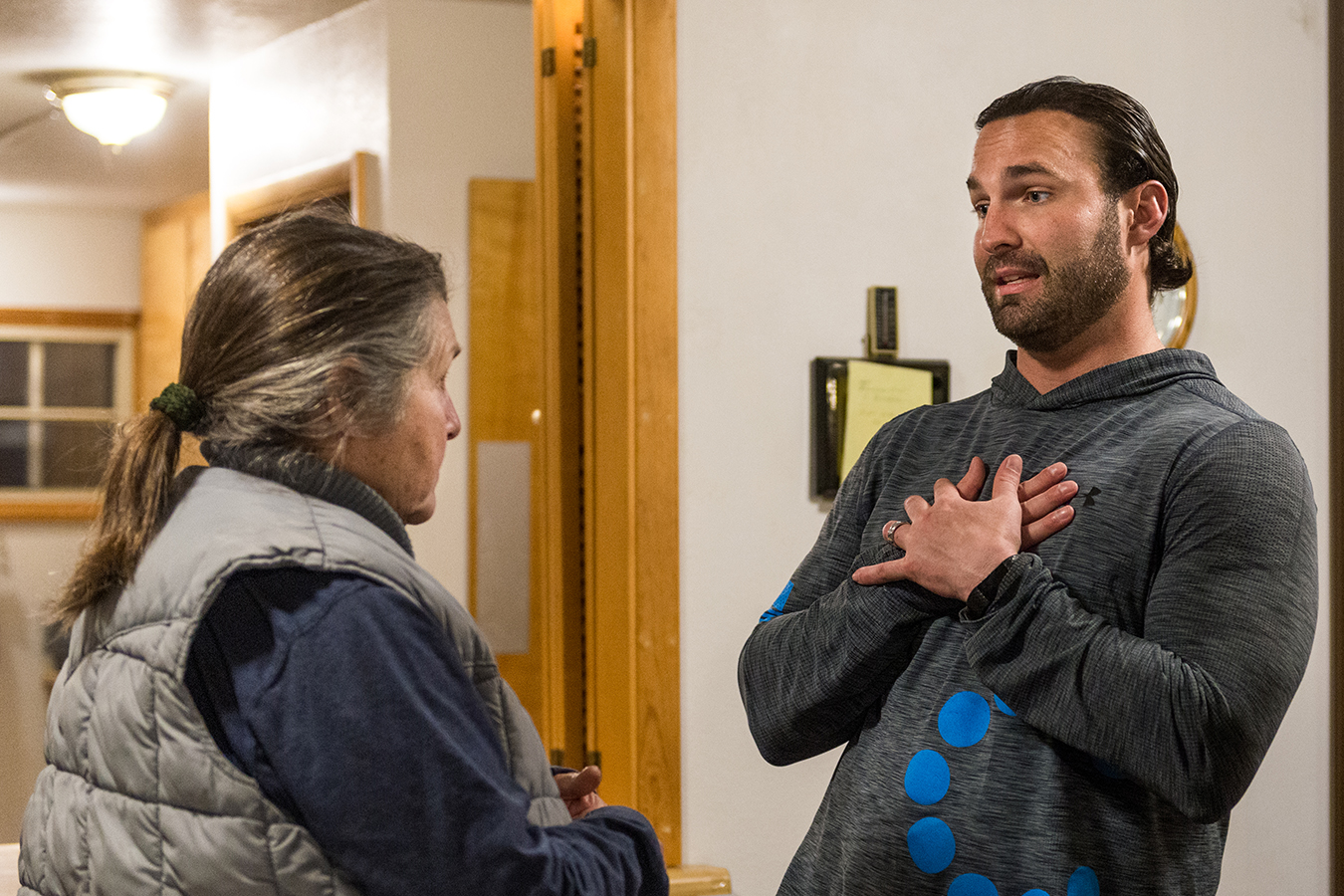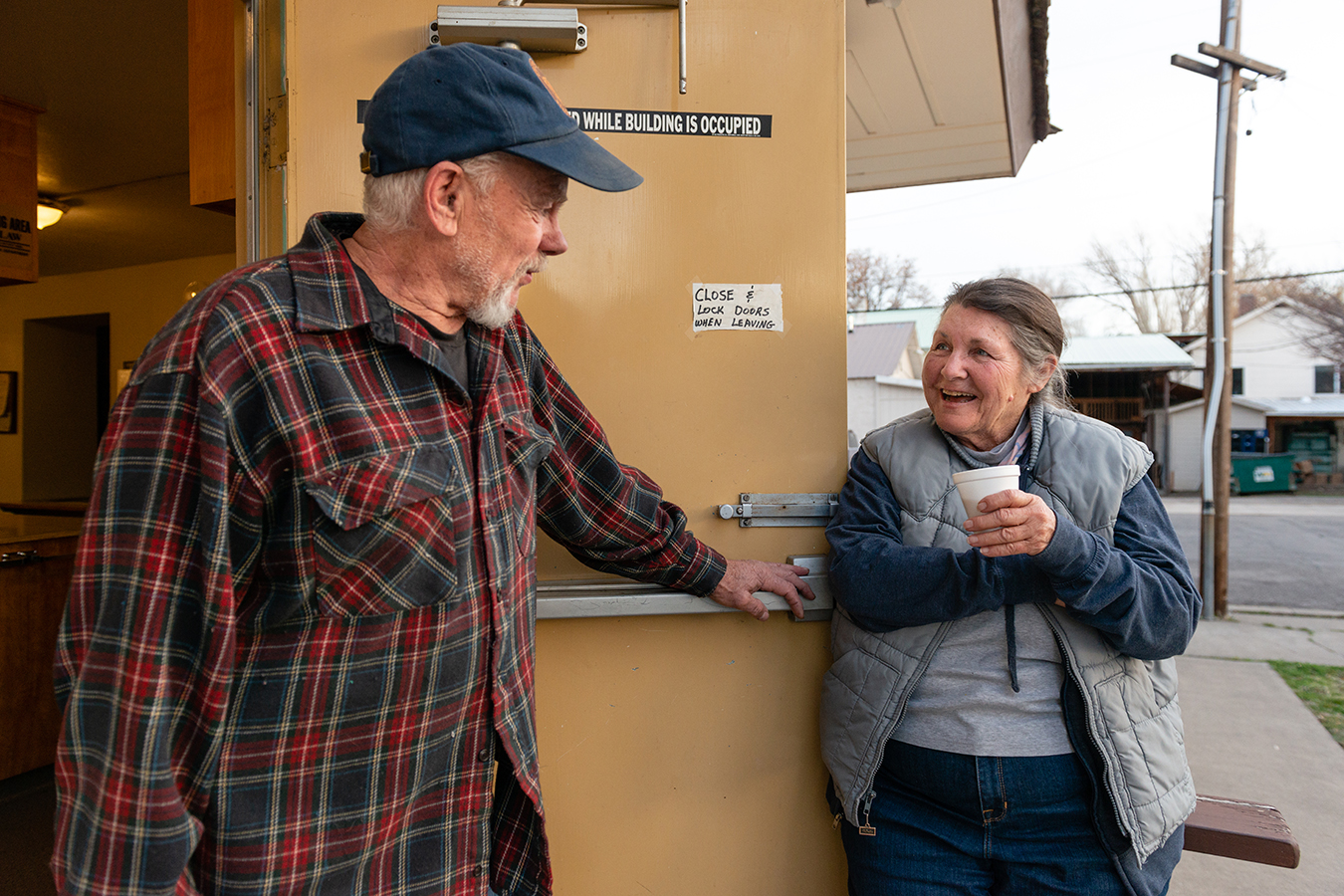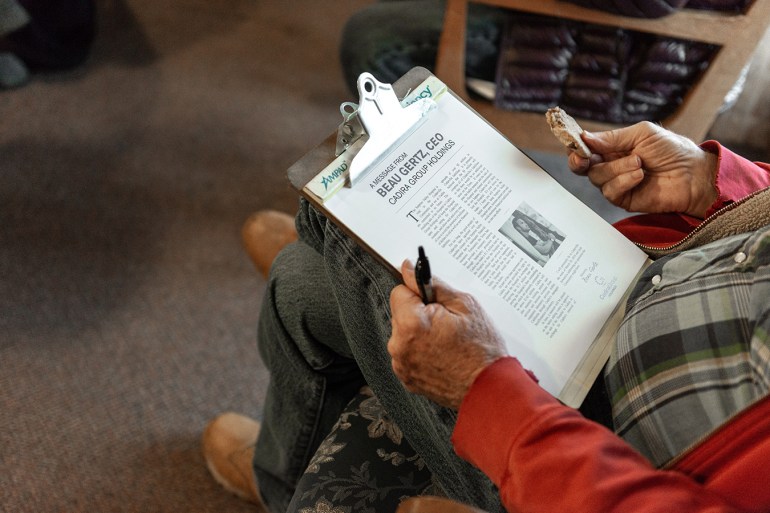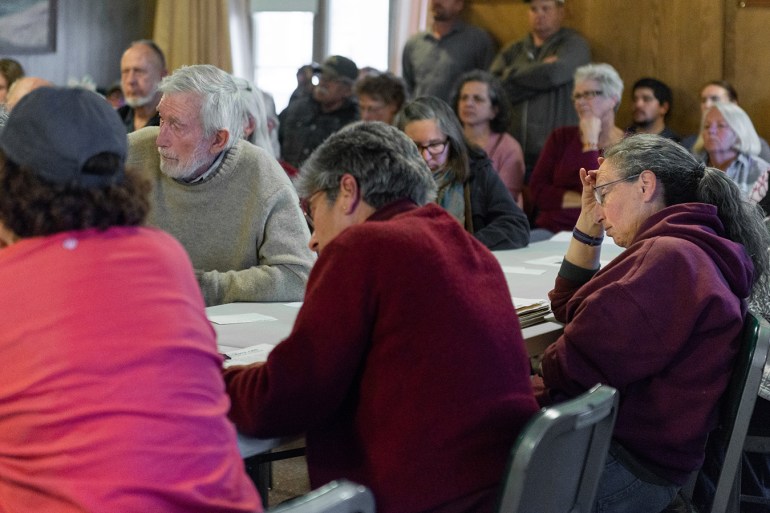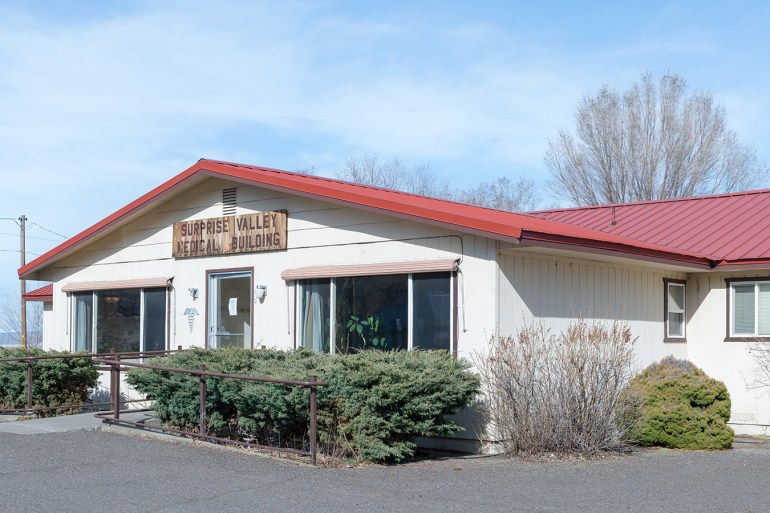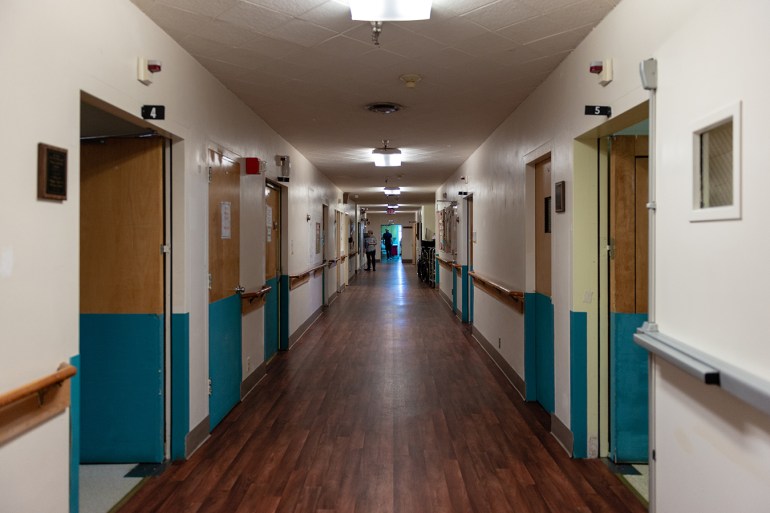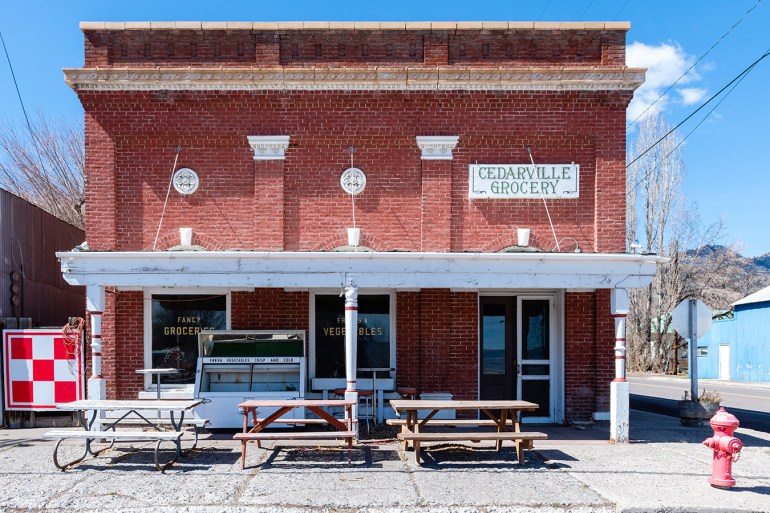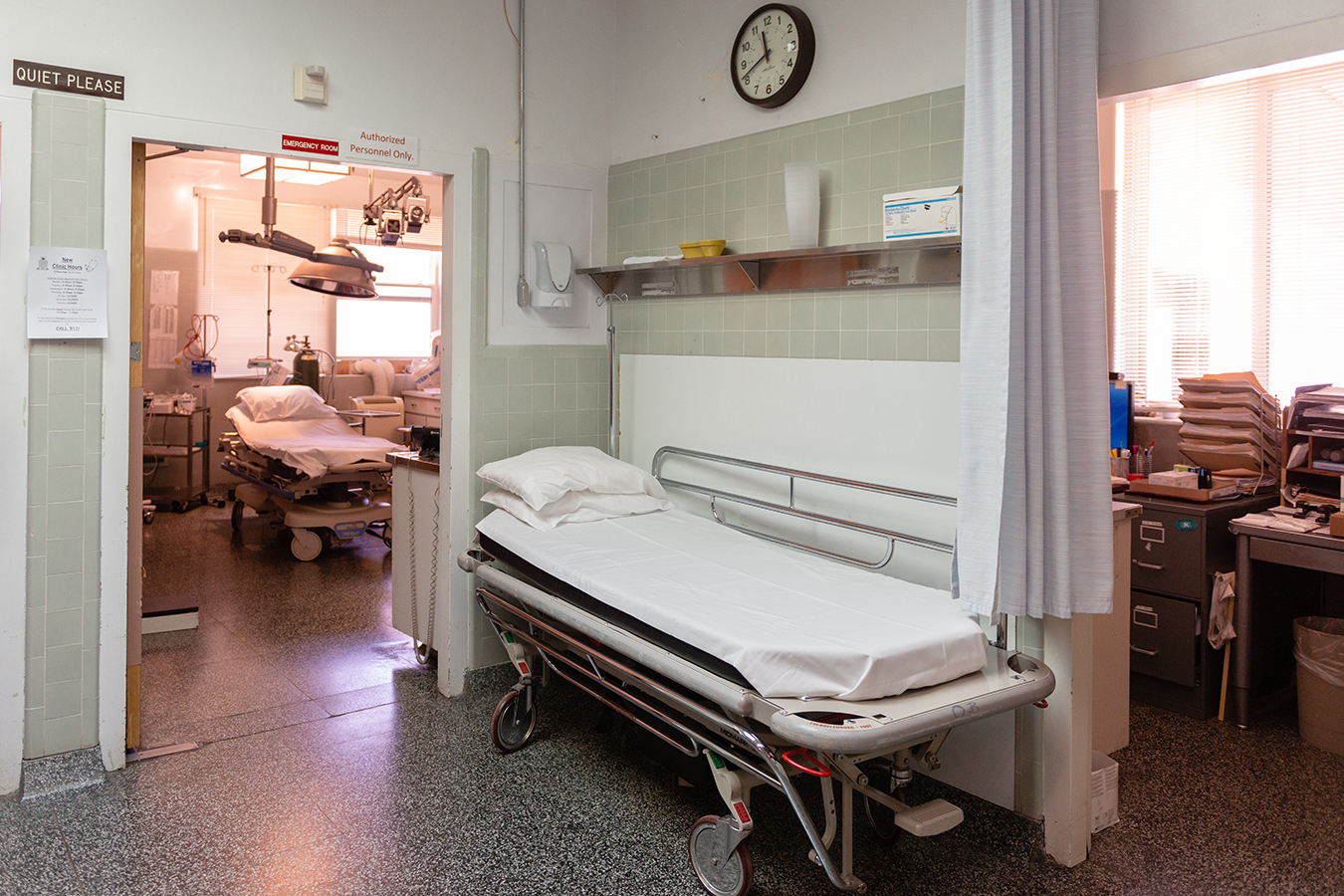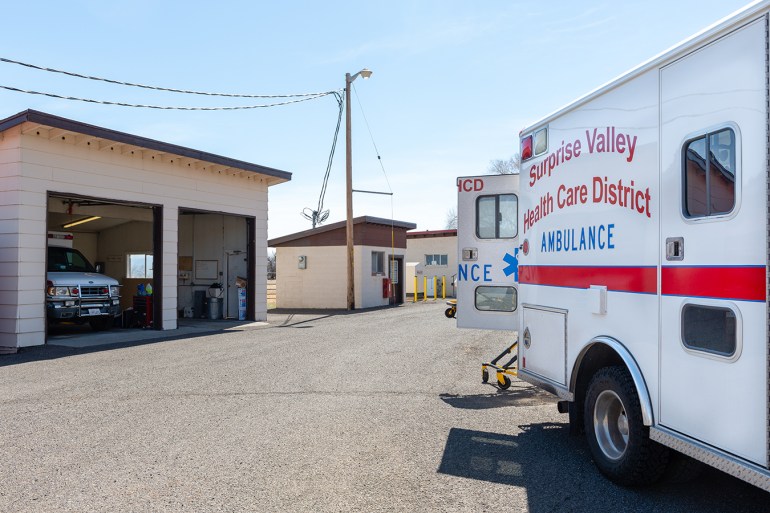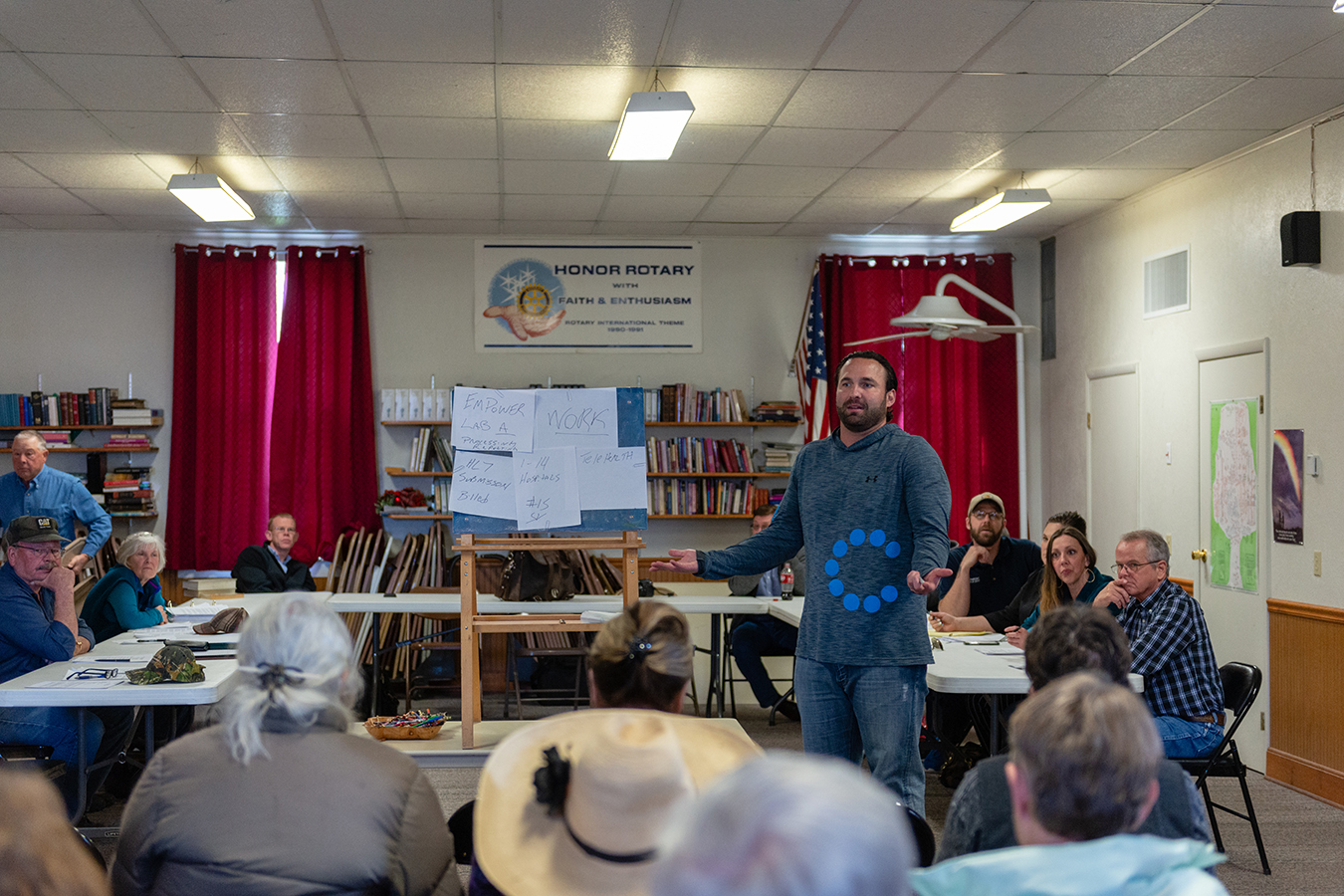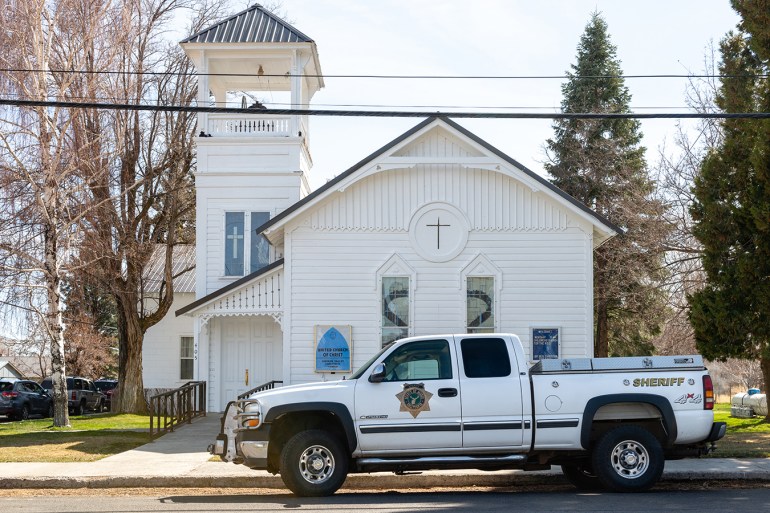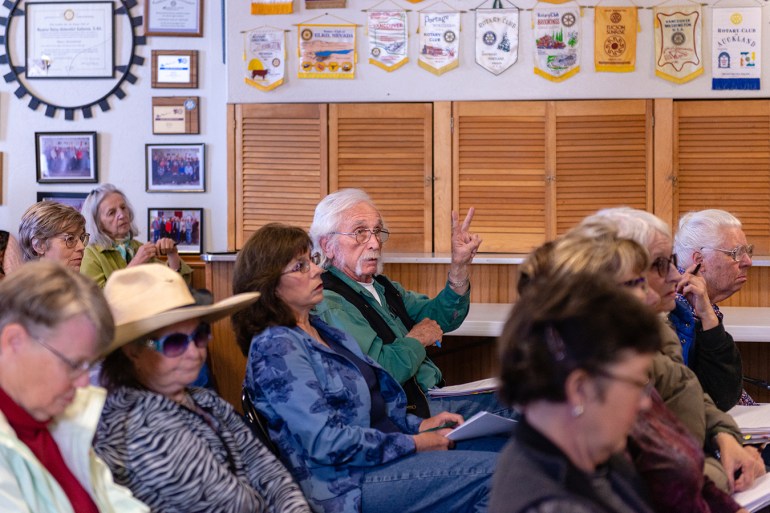Jeanne Goldman, 72, a retired businesswoman, talks with Beau Gertz after the town hall meeting. (Heidi de Marco/KHN)
CEDARVILLE, Calif. — Beau Gertz faced a crowd of worried locals at this town’s senior center, hoping to sell them on his vision for their long-beloved — but now bankrupt — hospital.
In worn blue jeans and an untucked shirt, the bearded entrepreneur from Denver pledged at this town hall meeting in March to revive the Surprise Valley Community Hospital — a place many in the audience counted on to set their broken bones, stitch up cattle-tagging cuts and tend to aging loved ones.
Gertz said that if they voted this week to let him buy their tiny public hospital, he would retain such vital services. Better still, he said, he’d like to open a “wellness center” to attract well-heeled outsiders — one that would offer telehealth, addiction treatment, physical therapy, genetic testing, intravenous vitamin infusions, even massage. Cedarville’s failing hospital, now at least $4 million in debt, would not just bounce back but thrive, he said.
Gertz, 34, a former weightlifter who runs clinical-lab and nutraceutical companies, unveiled his plan to pay for it: He’d use the 26-bed hospital to bill insurers for lab tests regardless of where patients lived. Through telemedicine technology, doctors working for Surprise Valley could order tests for people who’d never set foot there.
To some of the 100 or so people at the meeting that night, Gertz’s plan offered hope. To others, it sounded suspiciously familiar: Just months before, another out-of-towner had proposed a similar deal — only to disappear.
Outsiders “come in and promise the moon,” said Jeanne Goldman, 72, a retired businesswoman. “The [hospital’s] board is just so desperate with all the debt, and they pray this angel’s going to come along and fix it. If this was a shoe store in Surprise Valley, I could care less, but it’s a hospital.”
Looking For Salvation
The woes of Surprise Valley Community Hospital reflect an increasingly brutal environment for America’s rural hospitals, which are disappearing by the dozens amid declining populations, economic troubles, corporate consolidation and, sometimes, self-inflicted wounds.
Nationwide, 83 of 2,375 rural hospitals have closed since 2010, according to the North Carolina Rural Health Research Program. These often-remote hospitals — some with 10, 15, 25 beds — have been targeted by management companies or potential buyers who promise much but often deliver little while lining their own pockets, according to allegations in court cases, a Missouri state audit and media reports.
Enticed by such outsiders, some struggling rural hospitals around the country have embraced lab billing for faraway patients as a rescue plan. That’s because Medicare and commercial insurers tend to pay more for tests to sustain endangered rural hospitals compared with urban hospitals and especially outpatient labs. In general, this kind of remote billing is controversial and legally murky, and it recently has resulted in allegations of fraud in several states, according to government documents and media reports.
Rural hospital boards, however, tend not to have expertise in the health care business. The president of Surprise Valley Community’s board, for instance, is a rancher. Another board member owns a local motel; a third, a construction company. That lack of experience “leaves them vulnerable in many cases,” said Terry Hill of the nonprofit National Rural Health Resource Center, based in Duluth, Minn.
Seeking to distinguish himself from other would-be rescuers who ran into legal trouble, Gertz described his proposal to residents as perfectly legal — a legitimate use of telemedicine, essentially remote treatment via electronic communication such as video. “If you do it correctly,” he said in an interview with Kaiser Health News, “there is a nice profit margin. There [are] extra visits you can get from telemedicine but … it has to be billed correctly and it can’t be abused.”
Gertz runs several companies — founded within the last four years —including two labs, SeroDynamics and Cadira Labs, as well as a wellness company called CadiraMD.
He pledged in court documents to buy the bankrupt hospital for $4 million and cover its debts, saying he had lined up a $4 billion New York company as a financial backer. Kaiser Health News was unable to locate the company under the name Gertz cited, Next Genesis Development Group. He did not respond to emails seeking clarification on the issue.
Gertz, who acknowledged that he had never before run a hospital, was asked at the same gathering whether he had disclosed his “financials” to the hospital board. “As a private entity, I don’t have to show my financials and I have not provided my financials to the board,” he replied.
It was not clear whether board members had ever asked. Surprise Valley Health Care District board President John Erquiaga declined to comment.
A Sad Decline
Surrounded by the Warner and Modoc mountains and forests in California’s northeastern corner, Surprise Valley is home to four small communities. The largest is Cedarville, population 514, at last count.
The valley, covered in sagebrush and greasewood, is part of Modoc County, one of California’s poorest, with a median income of about $30,000. The closest hospital with an emergency room is roughly 25 miles away, over a mountain pass.
One of hundreds of rural hospitals built with help from the 1946 federal Hill-Burton Act, the Surprise Valley hospital opened in 1952 to serve a thriving ranching community. But it has struggled since, closing in 1981, reopening as a health clinic in 1985, then reconverting to a hospital in 1986.
A county grand jury report in 2014-15 found that “mismanagement of the [hospital district] has been evident for at least the past five years.”
By last summer, those in charge didn’t seem up to the task of running a modern hospital. By then, it was hardly a hospital at all. Crushed by debt, it primarily offered nursing home care, an emergency room, a volunteer ambulance service and just one acute care bed, with three others available if needed.
When state inspectors arrived last June, they found chaos. The hospital’s chief nursing officer resigned during the inspection. Staffers reported unpaid checks to vendors hidden in drawers. Inspectors learned that the hospital had sent home temporary nurses because it couldn’t pay them, according to their report.
The hospital’s then-chief administrator, Richard Cornwell — who staffers said had instructed them to hide the checks, according to the report — had taken a leave of absence and was nowhere to be found. Cornwell, a health care accountant from Montana, was later fired and replaced with the hospital’s lab director, who in turn resigned, according to public records. Reached by Kaiser Health News, Cornwell declined to comment.
Federal regulators suspended Medicare and Medicaid payments to the hospital — a rarely invoked financial penalty — over concerns about patient care. Those payments have since been reinstated, but a follow-up state inspection in November 2017 identified more patient care concerns.
Infighting ensued, with some residents fiercely committed to keeping the hospital open and others favoring closure, perhaps replacing it with a small clinic. Local journalist Jean Bilodeaux, 74, said board members often kept the public in the dark, failing to show up for their own meetings and sometimes making decisions outside public view.
When Bilodeaux raised questions about the hospital’s finances in the Modoc County Record, a weekly newspaper, she recalled, board members “started screaming at me,” she said. Now “I don’t even step foot in that hospital.”
Ben Zandstra, 65, a pastor in Cedarville, said that while Cornwell was in charge, he too got a chilly reception at the hospital, where he had long played guitar for patients on Christmas Eve. “I became persona non grata. It’s the most divisive thing I’ve seen in the years I’ve lived here.”
A White Knight, Vanished
Even residents who say they have experienced poor care at Surprise Valley Community believe its continued existence in some form is crucial — for its 50 or so jobs, for its ER, and because it puts the region on the map.
Eric Shpilman, 61, a retired probation officer, said his now-deceased wife received “unspeakable” treatment at Surprise Valley. But to shut it down? “It would take out the heart of Surprise Valley, the heart out of Cedarville.”
Last summer, the board turned to an outside management company for help.
Jorge Perez, CEO of Kansas City-based EmpowerHMS — which promises on its website to “rescue rural hospitals” — agreed to take over Surprise Valley’s debt and operate the hospital for three years, according to a management agreement with the board.
In the two months after EmpowerHMS took over management, Surprise Valley’s revenue more than doubled, according to financial documents provided by the hospital.
Then, according to hospital officials’ public statements, the company stopped making the promised payments, and they haven’t been able to contact EmpowerHMS or Perez since. In January, when Surprise Valley filed for bankruptcy, documents filed in court said EmpowerHMS had “abandoned” the hospital.
Around the time Perez took over, he and companies with which he was involved were dogged by allegations of improper laboratory billing at facilities in Mississippi, Florida, Oklahoma and Missouri, according to ongoing lawsuits by insurers and others, a state audit and media reports. Missouri’s attorney general in May opened an investigation into one of the hospitals Perez managed, and Sen. Claire McCaskill (D-Mo.) recently called for a federal investigation into lab billing practices at one of the hospitals.
Medicare rules and commercial insurance contracts, with some exceptions, require people to be treated on an inpatient or outpatient basis by the hospitals that are billing for their lab tests. But insurers have alleged in court documents that hospitals Perez was involved with billed for tests — to the tune of at least $175 million — on patients never seen at those facilities. Perez has maintained that what he is doing is legal and that it generates revenue that rural hospitals desperately need, according to Side Effects Public Media.
Experts say insurers are catching on to voluminous billing by hospitals in communities that typically have generated a tiny number of tests. At one Sonoma County district hospital not associated with Perez, an insurer recently demanded repayment for $13.5 million in suspect billings, forcing the hospital to suspend the lucrative program and put itself up for sale.
Lab tests for out-of-town patients have “been a growing scheme in the last year, slightly longer,” said Karen Weintraub, executive vice president of Healthcare Fraud Shield, which consults for insurers. “There’s an incentive to bill for things not necessary or even services not rendered. It also may not be proper based on contracts with insurers. The dollars are getting large.”
Some residents were aware of controversy surrounding Perez and his companies and said they tried to warn the hospital district board. “All they wanted to hear was, ‘We will pay the bills,’” Bilodeaux said.
Neither Perez nor EmpowerHMS returned requests for comment. However, Michael Murtha, president of the National Alliance of Rural Hospitals, said in an email that he was responding on behalf of Perez, who chairs the coalition’s board.
“The mission to rescue rural hospitals and set them on a path of sustainability is a difficult undertaking, and it would be a disservice to their communities to preclude struggling facilities from availing themselves of every legal and regulatory means to generate badly needed revenue,” Murtha wrote, in part.
“Such pioneering efforts are not always welcomed by those who have benefited from the status quo,” he said.
Regarding Perez’s role at Surprise Valley, Murtha wrote that Perez tried to help save the facility by “effectively” donating over $250,000 but then discovered it faced “more challenges than had been initially realized.” Murtha said Perez worked to attract others who might be better able to help the hospital.
A New Savior?
One of those “others” in Perez’s orbit was Gertz, the Denver entrepreneur, who arrived in Surprise Valley several months ago.
The Denver executive told residents and Kaiser Health News that he operated a lab that previously performed tests for hospitals owned or managed by Perez’s companies. At one hospital board meeting, Gertz also said he had handled marketing for Perez companies for 1½ years.
However, he said he had parted ways with Perez after learning of his controversial dealings in other states, and Gertz said Perez now owes him more than $14 million. (Gertz and his companies have not been named as defendants in lawsuits reviewed by Kaiser Health News involving Perez and his companies.)
“I come in with a certain guilt by association,” he told the Modoc County Board of Supervisors in April, according to a recording of the meeting. But Gertz sought to assuage any concerns, telling the supervisors he had a “passion” for rural life. He’d grown up on a farm, he said, where he “hung out with the chickens” and cleaned the stables every morning.
Gertz said his plan was different from Perez’s and legal because the hospital and one of his Denver labs, SeroDynamics, had become one business. With the hospital board’s approval earlier this year, he loaned the district $2.5 million for it to buy SeroDynamics — effectively an advance on the hospital’s purchase price of $4 million, according to bankruptcy court documents. SeroDynamics’ website now proclaims the lab a “wholly-owned subsidiary” of the Surprise Valley hospital, with “national reach.”
Robert Michel, a clinical laboratory management consultant who learned of the terms of the transaction from a reporter, offered a critical assessment. “The essence of this arrangement is to use the hospital’s existing managed-care contracts with generous payment terms for lab tests as a vehicle to bill for claims in other states,” said Michel, editor-in-chief of a trade magazine for the lab industry. This arrangement “should ring all sorts of bells” for the hospital board, he said.
Meanwhile, Gertz has said, dollars are flowing in. According to the journalist Jean Bilodeaux, Gertz phoned in to a Surprise Valley hospital board meeting last month to report that the lab billing so far had netted about $300,000. According to bankruptcy court documents, 80 percent of the profits will go to his companies, 20 percent to the hospital.
Those are terms some in Surprise Valley are willing to live with.
On Tuesday, an overwhelming majority of voters — 83 percent — threw in their lot with Gertz. The turnout represented a small fraction of the district’s approximately 1,500 residents, but it gave Gertz the nod he needed to buy the hospital.
Many residents said it was a choice between almost certain closure and the possibility — however uncertain — of revival.
As acting hospital administrator Bill Bostic put it before the vote: “He’s got something we haven’t got — which is money.”
This story was produced by KFF Health News, which publishes California Healthline, an editorially independent service of the California Health Care Foundation.
[Update: This story was originally published on June 4. It was updated at 4 p.m. ET on June 6 to reflect the results of the referendum.]



